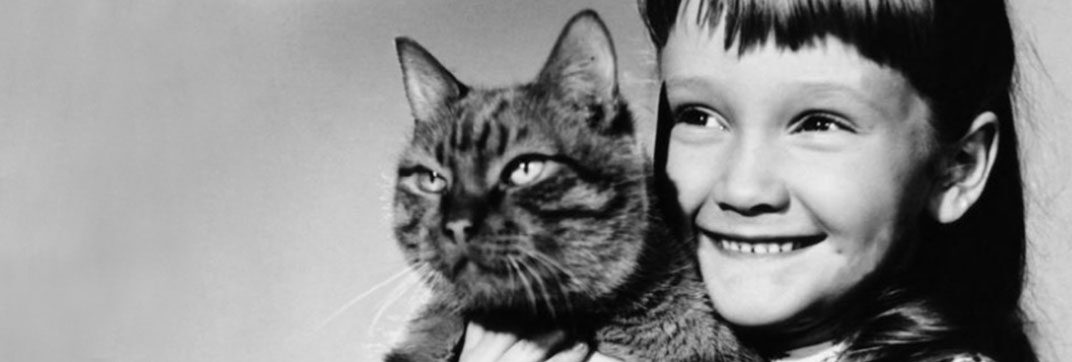Behind the Scenes of The Three Lives of Thomasina
Disney movies starring animals were certainly nothing new in the early 1960’s. But the same couldn’t be said of Disney movies starring cats. Cats in Disney movies, both live action and animation, were usually relegated to sidekick status or, even worse, cast as villains. While Disney was an admitted dog lover, he did finally recognize the appeal of cats and set out to include feline heroes and heroines in his studio’s library starting in this decade.
Paul Gallico, a noted former sportswriter and columnist, was an avid cat lover who wrote several books about cats, including Jennie, Abandoned, Honorable Cat and The Silent Miaow. In 1957 he penned what would be one of his most beloved cat novels titled Thomasina, the Cat Who Thought She was a God.
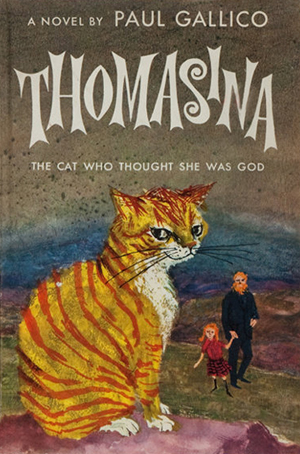
The book follows the story of a widowed Scottish veterinarian named Andrew MacDhui and his daughter Mary Ruadh whose pet cat Thomasina causes a rift between them which only love and God can put right. Walt Disney was apparently intrigued by the story and in 1962 he purchased the rights to the book and began production to bring Gallico’s story to the screen.
Don Chaffey was brought in to direct, having previously helmed the Disney film Greyfriars Bobby: The True Story of a Dog.
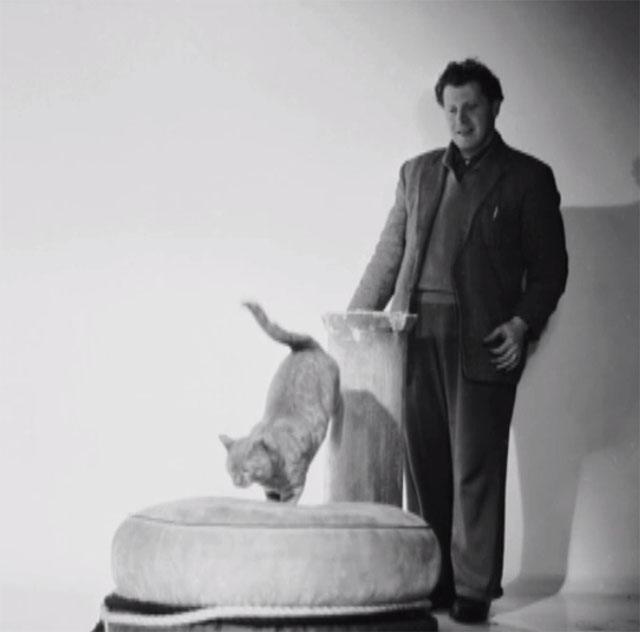
Casting was going to be very important for this project. Disney was said to be a stickler for authenticity yet hired Irish-American actor Patrick McGoohan to play Andrew MacDhui (McGoohan’s talent was such that playing a Scot would prove no problem). Susan Hampshire was hired to play Lori and took her preparation for the part seriously, bringing home several animals to her Chelsea flat including a deer, three rabbits, a jackdaw, mice and cats. After a few days she realized that was probably not the best situation and sent the animals back.

Noted casting director Maude Spector attended a performance of the play The Caucasian Chalk Circle playing at the Aldwych Theater in London where star Roy Dotrice’s four-year-old daughter, Karen, was appearing as a little boy. Something in her performance inspired Spector to suggest Karen Dotrice for the part of Mary. Also cast was the veritable scene-stealer Matthew Garber as Geordie McNab, one of the many boys who are friends to Mary and take up her cause when Thomasina is killed. Movie fans will know that after this film Matthew and Karen went on to star as the Banks children in Disney’s Mary Poppins which would garner much more attention than Thomasina.
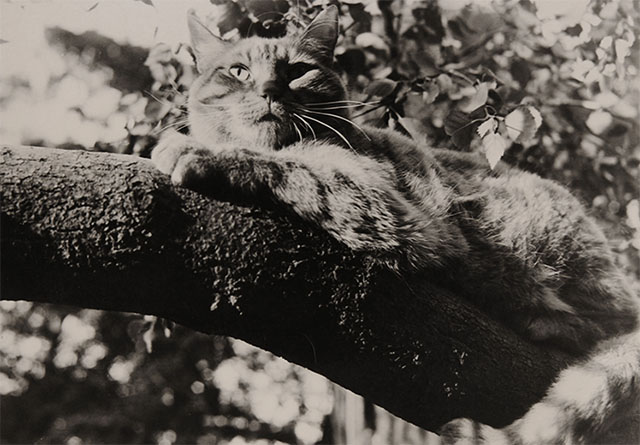
Who Can Talk Like a Cat?
What seemed even more important to Disney than the casting of the actual cat actors to play Thomasina (which was a task in and of itself) was the casting of the actress who would provide her voice. The film almost became even more of a Mary Poppins’ precursor when Glynis Johns was seriously considered for the part early on, as Hollywood Reporter Louella Parsons explained in her column on February 18, 1963:
HOLLYWOOD — Glynis Johns is such a fascinating person, as I learned when she came to see me straight from the set of her TV pilot, “Careful, My Love” (Desilu) all her plans seem exciting.
I’m dizzy trying to remember all of them but Glynis is very intrigued by the idea of playing the voice of Thomasina, the cat, in Walt Disney’s movie of Paul Gallico’s book of the same title. Walt thinks so highly of the way Glynis sounds as a feline that he’ll go to New York to direct her narration.
“We have to do it there before I open March 12 in George Bernard Shaw’s ‘Too Good to Be True.’
The Buffalo Evening News also reported on this possible casting on April 3, 1963, referring to a meeting between Walt Disney and Johns during their initial talks about Mary Poppins:
There had been something else in Walt’s mind. He wanted Glynis to be the voice of Thomasina the cat in his film version of Paul Gallico’s book about a feline who thinks she is smarter than people.
“Walt thinks I have a good cat’s voice,” said Glynis in those husky, yet soft tones which remind one of Jean Arthur.
Sadly Glynis Johns did not get the part. Neither did radio actress Ginger Pearson, who was said to have performed the voice of Thomasina in April 1963 according to an article in The Independent on August 15, 1963. But the part ended up going to Elspeth March, and her casting amidst the extensive search for Thomasina’s voice was reported in the Thanet Times and East Kent Pictorial on October 22, 1963:
Elspeth Will Not Be Seen
Walt Disney has handed distinguished London-born actress Elspeth March one of the most unusual and intriguing roles of her long and varied career. She will be heard but not seen as the voice of the title cat in Walt Disney’s “The Three Lives of Thomasina.”
The signing of Miss March ends an exhaustive search that has been going on for months, both in Britain and America.
More than 100 tests were conducted on both sides of the Atlantic for the challenging role, as the cat is the key figure, and the entire story is seen and narrated through its eyes.
Success came when Walt Disney heard a recording by Elspeth March which was flown to him in Hollywood.
The film takes place in Scotland and tells of a Scots veterinary surgeon whose misguided sense of duty loses him the love of his young daughter when he has to put her pet cat to sleep.
To be completely true to the Paul Gallico story, Miss March gave the four-year-old Thomasina a Scottish burr to its accent.
It is possibly the strangest role Miss March has ever undertaken since she first stepped on to the stage in December 1942 as the woman passenger in “Jonah and the Whale.”
Casting the Right Cat (or Cats)
Finding the right cat actor to play Thomasina was also extremely important and a search for the starring animal began right away. Although Thomasina is described in the book as having some white feet and markings, a red tabby (popularly known as a marmalade) cat was sought for the role. Never one to let a cat story get by him, columnist Harold Heffernan mentioned the search for the feline thespian in his column about the new trend of cats in movies on March 1, 1964:
Foremost among the “cat producers” is Walt Disney whose “Incredible Journey” started the current trend. The film, in which a Siamese shares honors with two dogs and stole the picture from them, will gross between $6 and $7 million.
Disney immediately rushed the Paul Gallico story, “Thomasina,” before the cameras. [He] placed ads in many British newspapers and had casting directors travel thousands of miles to find an ideal cat for “The Three Lives of Thomasina”.
“A marmalade cat, found in Southampton, was taken to London for a screen test. The coloring was right and the cat was agreeable,” notes Disney’s announcement, “so that became the right animal.” It cost 10 English pounds (about $25 per week) to feed her in fish and meat.
Disney points out that a cat picture has a ready made audience. There are 27 million cat-owners in the United States alone, according to the “census” a survey organization took, and in some other countries, notably Italy, the ratio of cats to people would run higher.
The Bedford Daily Times reported on the casting of the cat on November 5, 1964:
The same skill with which Walt chooses his human stars went into the casting of Thomasina, who has such an important role to play in the story.
Only after a nation-wide search in England was a reliable feline found which could undertake the rigorous four-month stint.
Of course numerous cats actually worked on the film, which is pretty apparent when the coat patterns and faces of Thomasina change from shot to shot. In the course of one scene she goes from having a Mackerel pattern to a Classic tabby pattern, sometimes with a white spot on the chest, and back again. The Mackerel patterened cat, or hero cat, seems to have been used for primary shots of Thomasina and important close ups while the Classic tabbies do most of the stunts and running scenes. None of the cat actors appeared to have received credit or were mentioned by name in any resource materials we could find.
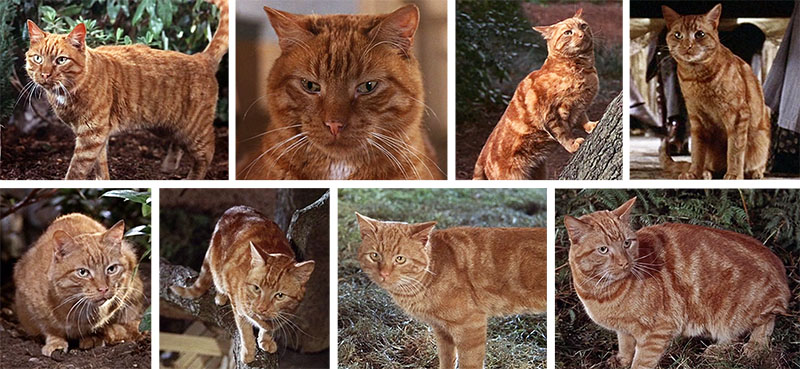
Working with the Cat Actors
Susan Hampshire explained the use of several cat actors during an interview for the film’s DVD release. She stated, “We had a lot of orange cats in the film because you can’t work cats non-stop in the same way that you can’t work children non-stop. They have their special hours. There were a lot of orange cats and you will notice in the film that they look a little different. And then sometimes the cats had to get wet. Well, you wouldn’t want the same cat to keep getting wet. I’m sure that the people who were in charge of the animals knew which ones were best for which shot. So there was a lot of consideration for the cats. They were all very nice, the cats.”
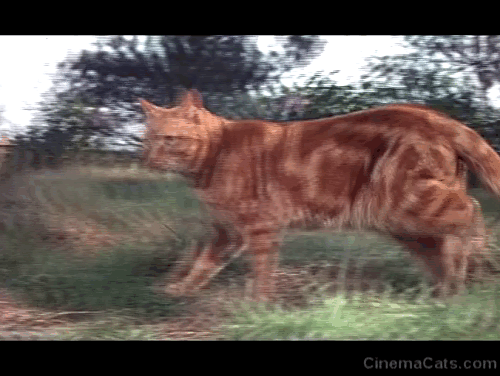
Karen Dotrice’s recollections of working with the cats on the set was quite different. “There were quite a lot of Thomasinas,” Dotrice explained to to Stu Shostak during an interview on his podcast, Stu’s Show, “And fact of the matter is they all hated me. This was bad animal energy. If you see the film I’m putting costumes . . . I’m dressing up my cat with a little bonnet and a pinnafore, so of course it flipping hated me. I was covered in scratches. It took me probably two decades before I adopted any feral animals any cats. I felt like, ‘Oh forget it, they all hate me.'”
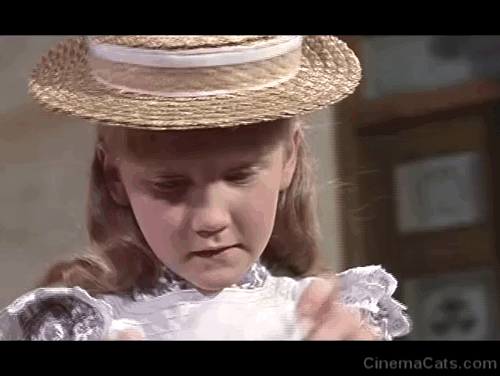
Karen Dotrice told Leonard Maltin much the same story on his podcast, adding, “There were lots of Thomasinas on that shoot, one that would sit and so whatever, and the one that would sit there with the little bonnet at the dinner table I had to feed it with a piece of ham and it always tried to take my hand off.”

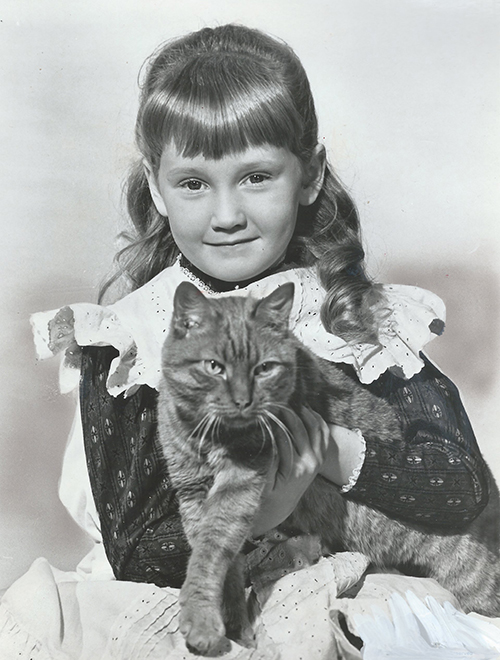
The Trainers Behind the Cats
The animals for the film were provided by Jimmy Chipperfield, who came from a family long associated with circuses and animal acts. But it was his daughter, Mary Chipperfield, who was the head animal trainer for the project. The Austin American Statesman sang her praises in an article published on May 22, 1964:
To audition 200 pounds of lethal dynamite in the deadly form of a lion, groom a rare and vicious condor for stardom or to teach a dog to rip the seat out of a pair of trousers without harming the victim is all in a day’s work for attractive 24-year-old Mary Chipperfield.
She is the holder of one of the world’s strangest jobs: animal casting director.
Mary, a member of a famous zoo and circus family, handled the animals for the feature motion picture, “The Three Lives of Thomasina,” her third production for Walt Disney.
With her dad, James Chipperfield, Mary was responsible for many of the thrilling animal highlights in “In Search of the Castaways.” Next she handled some 50 dogs who had important roles in “The Horse Without a Head.”
“We started our ‘stardom’ school for animals and birds because so many are now being used in films and we are constantly being asked to supply and train them,” Mary says.
The latest Chipperfield assignment for producer Disney, “Thomasina,” in the toughest. A marmalade cat takes the title role, with Patrick McGoohan and Susan Hampshire heading the human players.
To find Thomasina took months of patient and intensive searching. Homes throughout England were visited, advertisements placed in local and provincial newspapers and thousands of miles by road and rail travelled before the feline star was signed.
But the problem didn’t end there. Bears, cats, badgers, deer, foxes, owls, rabbits and squirrels all figure predominently on the animal casting list for the Paul Gallico story of a Scottish village and the human conflict that arises between a veterinary surgeon, his young daughter and a beautiful animal healer over disposition of a cat named Thomasina.
Mary, Britain’s youngest animal trainer — and certainly the most glamorous — has been working and living with animals since she was knee high to a dachshund.
Her first love is horses, and she worked the equestrian acts in the circus for many years. Now she has graduated to films.
Patience and kindness are the secrets of Mary’s job. When you have animals strange to each other, like foxes, badgers and cats, as in “Thomasina,” and require them to be in the same scene at the same time, only intense understanding and goodness will work.
Unfortunately the Chipperfield name would be forever tarnished when in 1999 Mary was fined on animal cruelty charges involving some of the animals in her circus. The newsreel footage above seems to show a woman working with animals who are not entirely happy with the way they are being handled and Karen Dotrice’s stories of being repeatedly scratched indicates something less than an ideal working situation.
While not particularly harsh, in the scene where Thomasina is in the fish market eating her prize as the two dogs approach her, it appears the cat actor is pushed out of the frame as the chase begins.
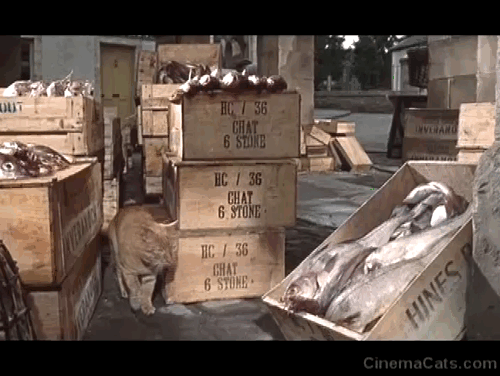
Less obvious to decipher are the scenes in which Thomasina is supposedly dead or rather sleeping deeply. It’s likely the cat was drugged for these moments, although in the shot where Mary first finds Thomasina stiff and hurt it is clearly a stuffed cat.
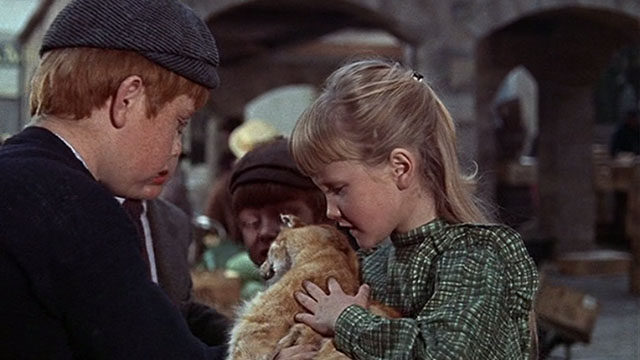
Siamese Cat Cattle Call!
In addition to the red tabbies, numerous Siamese cats were also employed for the notable cat heaven sequence. Susan Hampshire stated, “I know we had forty Siamese cats for the dream sequence.” While several actual Siamese cats are present for the scene, a majority of the cats appear to be either cutouts or a large matte painting, as evidenced in photos with Karen Dotrice posing with the felines. Note that in the actual scene most of the Siamese cats are not moving.
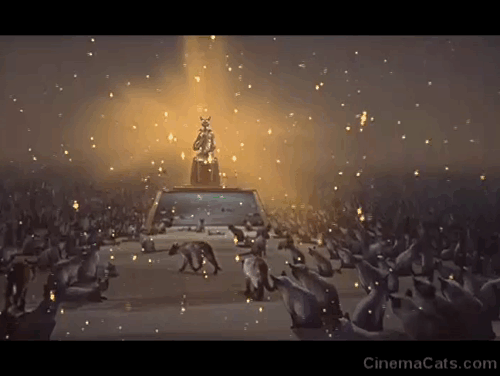
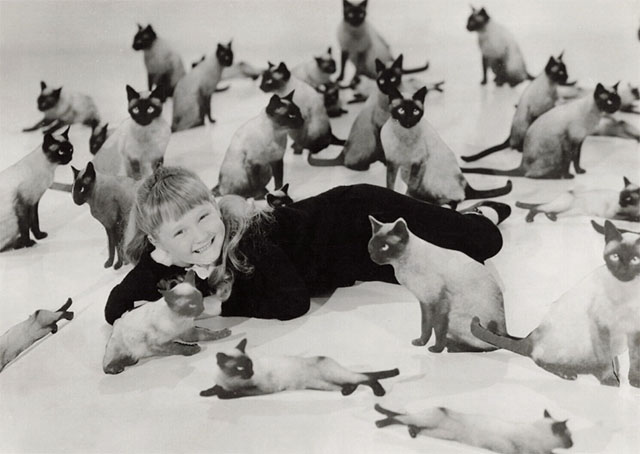
The Amazing Flying Cats
The heaven sequence was often singled out by reviewers as one of the highlights of the film and continues to be one of the most memorable cat scenes in movie history. Susan Hampshire explained in her DVD interview, “We had special cats that did ‘floating down” for the dream sequence.” Karen Dotrice added in one podcast episode, “Yeah, they did, they had cats to do everything. For the dream sequence there were cats bounced off of trampolines.” It appears the director had the cats bounced or dropped and slowed down the footage to make it appear the cats were tumbling through space.
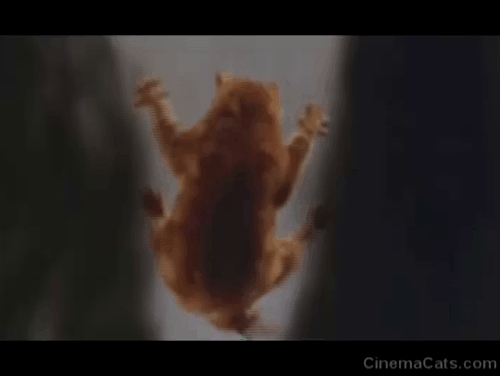
Real Location or Movie Set?
The movie was filmed largely at Pinewood Studios in London with some shots taken done in Black Park in Buckinghamshire. The Springfield Daily News explained the creation of the town in their review of the film published on June 14, 1964 (for some reason most newspaper articles state the fictional town’s name as Invereray, although in the film it is clearly Iveranoch. This may have been a mistake in the original press release.):
Walt Disney transformed the Pinewood studio lot in London into a giant replica of Inveraray. It took eight weeks to turn a French village set into Inveraray, with more than 100 workmen employed daily. Standing in an area 2,000 feet by 800 feet, there are some 30 houses, shops and a church in the village. Another feature is the imposing and realistic fishing market.
Changes to the Story (Warning, book spoilers ahead!)
Certain changes needed to be made to the original story to make it suitable as children’s fare. In the book Andrew (who is described as red-headed with a beard) is staunch atheist who has a shockingly callous attitude toward his practice and toward God Himself.
When Thomasina is injured (falling from Mary’s shoulders after being startled by a boat whistle), she begs her father to cure her. MacDhui quickly diagnoses the cat as having spinal meningitis and orders her euthanized. It doesn’t help that when Mary comes to him, MacDhui’s attention is focused on curing the seeing eye dog of the blind man Tammas. Saving the dog makes MacDhui feel like he has done something akin to saving a human patient. So it is heartrending when MacDhui accompanies his Reverend friend Angus to Tammas’ house to find the blind man has died of a heart attack (clearly too dark a turn to include in the film). He doesn’t even remember what has happened to Thomasina and this, plus other events, drives a wedge between himself and Mary Ruadh which causes her to treat him as if he didn’t exist.
Thomasina awakens to believe that she is the Egyptian cat god Bast and she struggles with the fact that everyone treats her like an ordinary cat. When MacDhui visits Lori, Thomasina does not remember anything about her past life with his daughter but knows that he is a cat killer and is determined to punish him for his crimes.
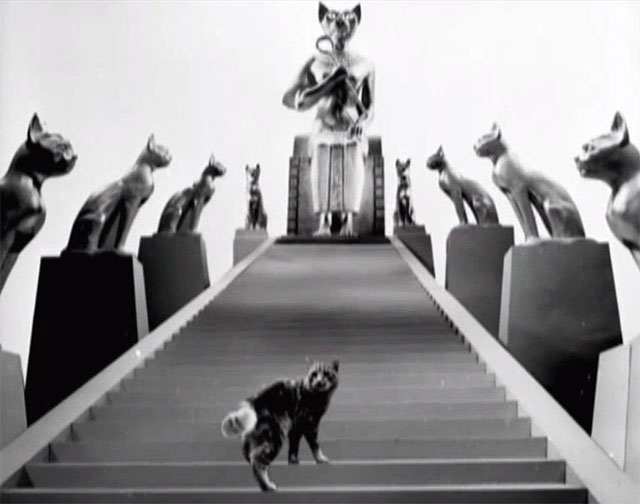
Thomasina believes she is controlling the things that happen to MacDhui, including setting him up to visit the gypsy circus where she hopes he will meet his doom. She does not forgive the man until he comes looking for Lori (whom he has fallen very much in love with and wishes to marry) and Lori does not answer the door to him. He stumbles upon Thomasina’s grave and falls to his knees and asks God for help, not knowing Thomasina is in the tree above him. She believe he is praying to her and therefore decides he deserves mercy.
When Thomasina finally remembers her former life with Mary, she returns to her. Lori is shocked to see the cat she has been calling Talitha is in fact the same cat Mary has been heartbroken over. It is made clear in the book that when MacDhui’s assistant put the cat down he did not give her enough choloroform and she had only been sleeping deeply when the children took her body from the garbage heap. This is something which is never made clear in the film.
For the movie the religous elements were seriously toned down and Thomasina only visits cat heaven but does not believe herself to be a god. This would also explain the change from the book’s original title. While including some of these story points would have made the movie a bit richer and more understandable (as a child watching the film I wasn’t sure if Lori really was a witch or whether or not Thomasina had actually died and come back to life) it made sense that the overall plot had to be compressed and Robert Westerby did a very good job adapting the book to the final screenplay.
Theatrical Release
The film was released in theaters on June 3rd, 1964 but ran as a special engagement in New York City on December 11, 1963. Reviews were somewhat mixed, with a few admitted curmudgeons downright panning the film. But overall the critics found many things to like about the movie, even if they weren’t sure children would understand the story’s deeper meaning. One review by Dorothy Masters which veered decidedly to the positive side was published in the Daily News on December 12, 1963:
Disney Fairy Tale — Holiday Family Fare
“The Three Lives of Thomasina” is an entrancing rarity in today’s exploitation of naked passions and peephole exposure. With fairy tales so hard to come by, this one is a boon to those in search of family fare for the holidays.
It has the most adorable witch you’ll ever see, a frisky marmalade cat, a volatile little girl, mischievous boys and a handsome veterinarian whose bedside manner is too brusque, even in Scotland, to make him popular with the natives.
There is a wondrous cat heaven, plus big excitement at a gypsy circus, marvelous settings, captivating fauna, delightful sentiment.
Paul Gallico, who authored “Thomasina,” is fully at home with cats — about 20 by recent tally — and also well versed in human nature. His characters are people everybody recognizes and they communicate with ease. Otherwise they wouldn’t have Walt Disney as a sponsor.
Disney filmed the Guild Theatre Production abroad, reconstructing the early 20th Century background, and staffed it with a fine British cast.
Publicity for the film came in the way of print ads, lobby cards and movie posters, often using the taglines, “I am Thomasina — a most unusual cat . . . they say I’m enchanted, and I AM!”
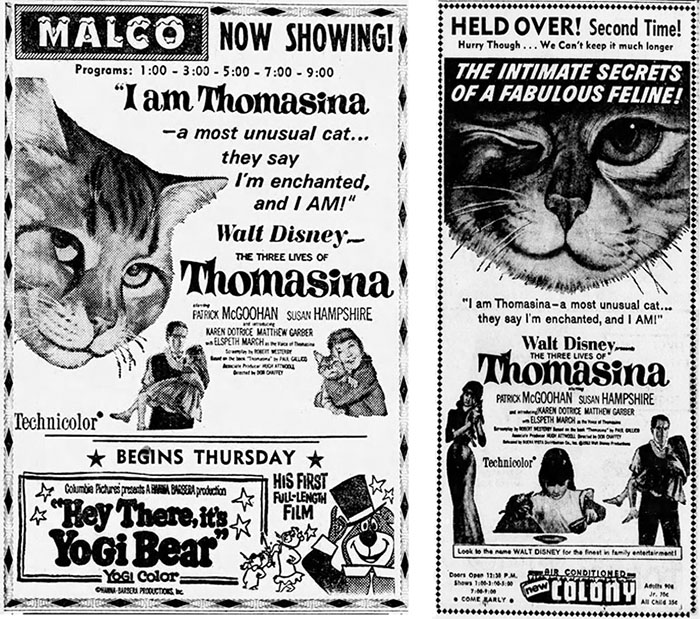
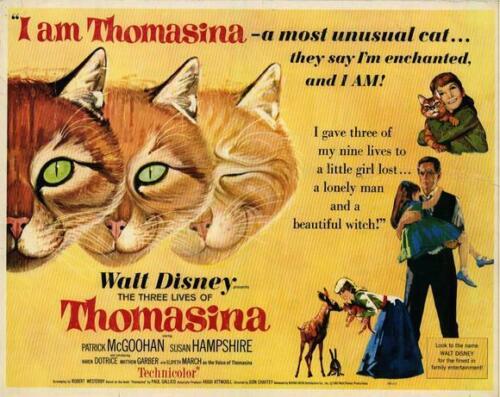
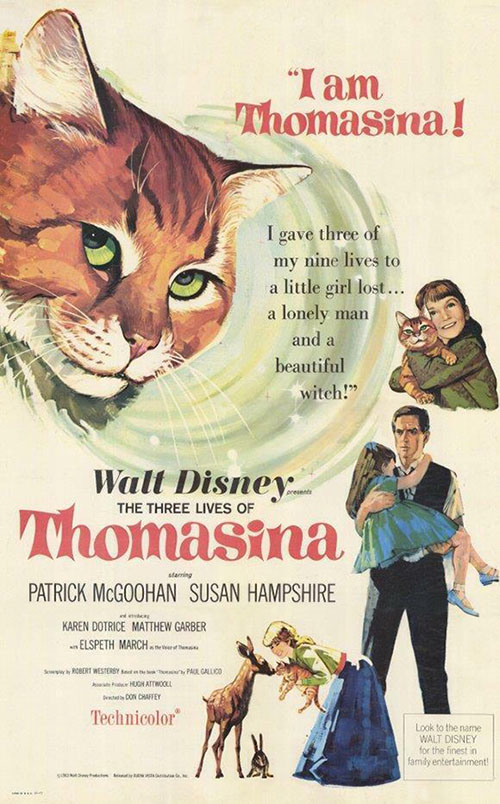
The Lincoln News Messenger, a local paper covering Lincoln, California, even managed to tie the movie in with promotions for local stores!
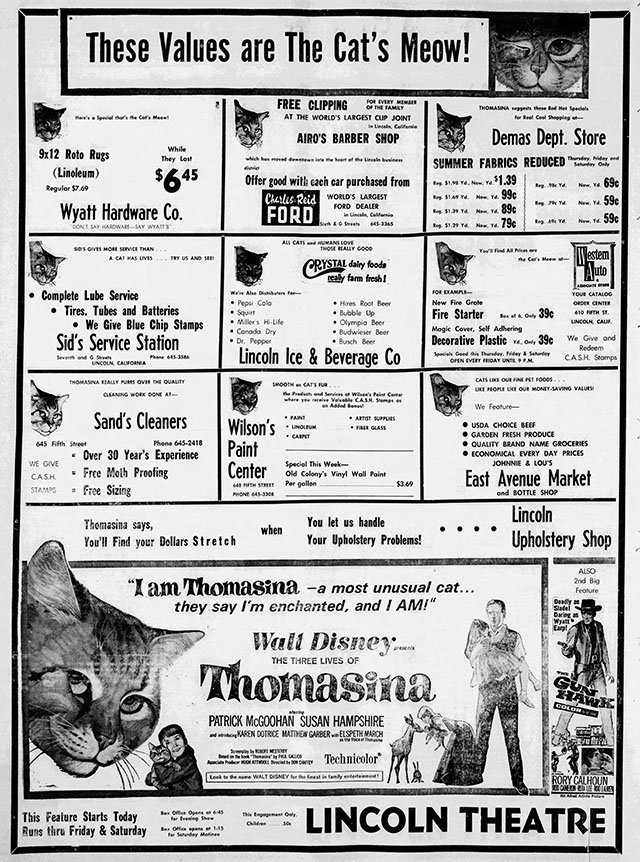
Not much merchandising appears to have been created during this release. A paperback copy of Gallico’s book was published, but we don’t know if the story printed within is the original tale or an adaptation closer to the Disney version.
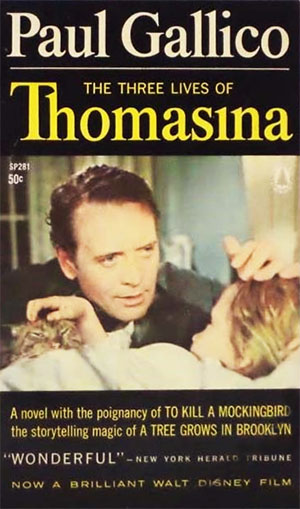
Television Debut
The television debut of the film was presented on Walt Disney’s Wonderful World of Color as a three part movie starting on November 14, 1965. Walt Disney even recorded a special introduction in which he appeared with four cats in his office. A ginger tabby sitting by the bookshelf even looks a lot like one of the Orangey team (which is possible, since Frank Inn had a working relationship with the Disney studios).
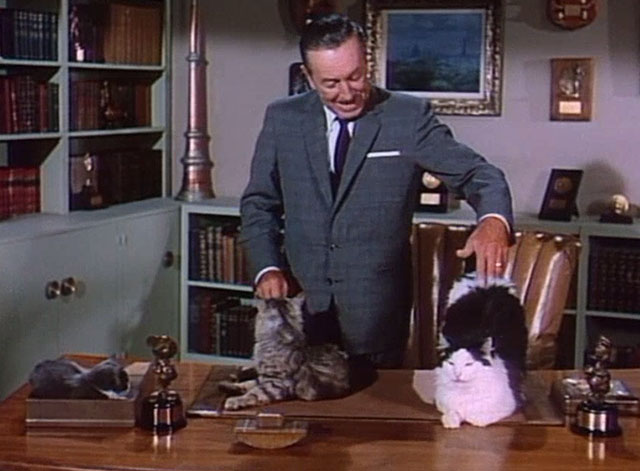
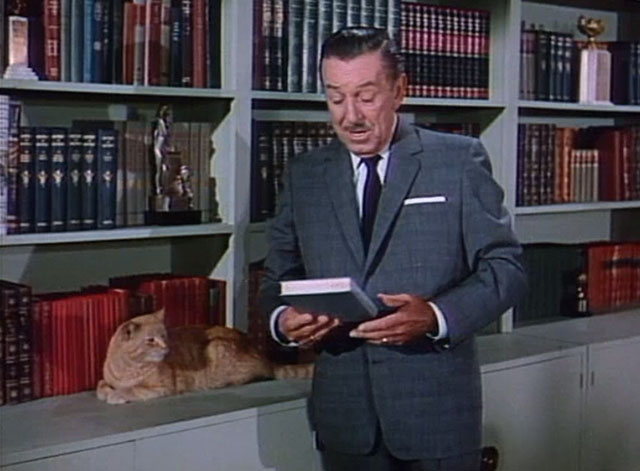
“On this program we’re going to tell you a story about a cat,” Walt explains, “A very exceptional cat, the heroine of this book Thomasina by my friend Paul Gallico, who’s a great cat man, as you may know. Now, for me I’m a dog man.” The cats on the desk give Walt a shocked look. “Oh, I like cats, don’t get me wrong,” he assures them, “I’ve had cats of my own. I like all animals! But I must be honest with you, I’ve always had a special feeling for dogs. But cats are pretty special, too, you know.”
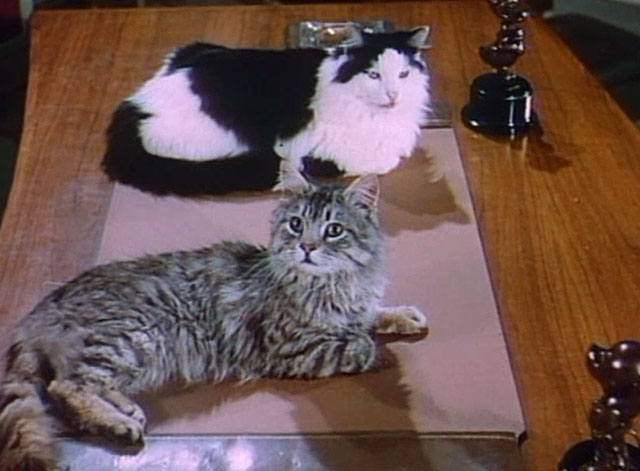
As he strokes the ginger tabby, Walt continues, “Now if this one could talk, he’d probably say ‘Can you jump ten times your own height? And if you humans in proportion to your own size were as fast as I am, you’d be able to run . . . how many miles? . . . one hundred miles an hour! And do you wash twenty times a day? And can you lick the back of your neck?” Walt walks back to his desk and continues to expound upon many interesting facts about cats.
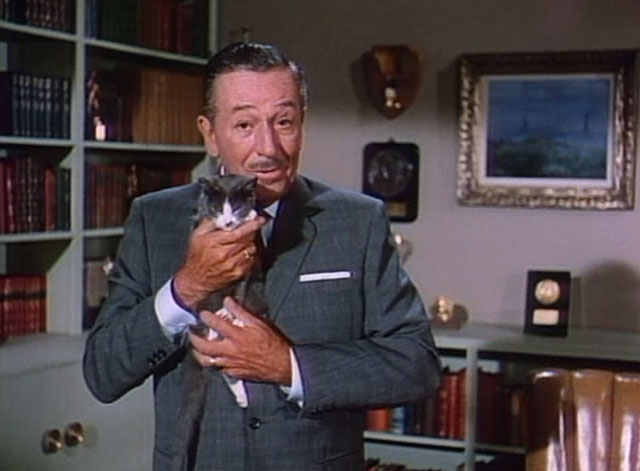
The Music
While Thomasina differed from many Disney favorites by not including songs, the opening tune became a favorite ballad for many fans. It must be noted that the theme song in the film and the single which was released were not only sung by different artists, but are done in different musical styles with completely different lyrics! Written by Terry Gilkyson, the film’s theme song is performed by Robie Lester (who also calls Thomasina’s name after the male vocals introduction) and the lyrics address Thomasina as a cat from the beginning. This version is upbeat and has a carousel-style sound.
The single version was performed by The Wellingtons (of Gilligan’s Island theme song fame) and the lyrics are more obscure, sounding like an Italian love song with a slow and melodic pace. In fact if you were not familiar with the source of the material you might be surprised by the final line in which they reveal, “Thomasina, still you’re my favorite cat” (very reminiscent of the song When I Look in Your Eyes from Dr. Doolittle). This latter version was also available as part of a collection of cat-related Disney songs on the soundtrack album for The Artistocats.
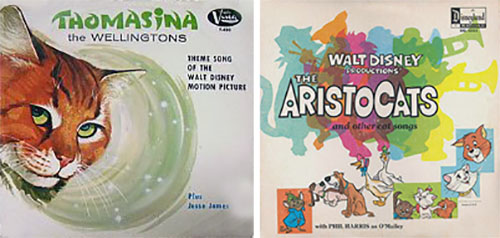
The Mystery of a Cat Named Kim
On the heels of Thomasina and The Incredible Journey, Disney embarked on yet another cat-centric film based on the book Undercover Cat (later retitled That Darn Cat!) We will cover the story behind That Darn Cat another time, but part of an article by Sheilah Graham in The Birmingham News on October 31, 1963 announcing the acquisition of the book from the Gordons, the husband and wife writing team known for their mystery novels, did mention Thomasina in a most confusing way:
Whopping Black Alley Cat Named Kim Disney’s Pick to Star in Gordon’s Tale
HOLLYWOOD, (N A N A) — The Gordon Gordons, Hollywood’s famous husband-wife writing team, never sit down to their collaborating typewriters to whip out a best-selling mystery novel without first drawing up a movie casting sheet.
Six of their 12 whodunits have been sold to motion picture studios and with each went along recommendations for choice of actors.
However, in marketing their latest work, “Undercover Cat,” the authors were at a loss as to which of a dozen top-rated Hollywood felines should be assigned to the title role. They were stumped, that is, until Walt Disney, hearing about their story, took over the casting problem himself.
After reading the galley proofs, Disney promptly bought the story as a vehicle for this latest discovery — a big black alley cat named Kim.
The Gordons didn’t know, but all the time their story was being developed Disney was searching everywhere for a script that might prove a fitting follow-up for Kim’s debut, which is set for Christmas time in a Disney film titled, “The Three Lives of Thomasina.”
Never before, his aides declare, has the producer become so fascinated by the performance of an animal and when he heard of the Gordon’s story — about a filthy neighborhood cat that eventually supplies the key to a murder mystery — he got in touch with them personally.
Wait, what??? A black cat? Kim???
This was obviously a major misunderstanding on the part of the writer (Could the hero cat who played Thomasina have been named Kim??) but we were curious about this black cat Disney was so excited about. We believe we did solve the mystery, at least in part, with this passage from Harold Heffernan’s article in The Boston Globe from March 1, 1964 which we referenced earlier, about the rise of interest in cats for movies which quoted Orangey’s trainer Frank Inn:
Because of the demand for top cat actors in recent months, competition has become bitter among their “managers.”
“We work the same as agents do with two-legged actors,” said trainer Frank Inn. “When I heard Disney had bought ‘Undercover Cat,’ I got a copy of the book and read it at once. Then I began training two big black fellows — the one in the book is black — so that when Disney is ready to cast the part, I’ll have two actors to offer him. If he decides not to use a black cat, which he may since it is difficult to photograph one at night time, I’ll have Rhubarb waiting in the wings. And you know, I have a feeling Rhubarb will end up with the role.”
Whether or not one of these black cats referenced here was Kim, we may never know. But we do know for sure that whoever he or she was a black cat certainly did NOT play Thomasina!
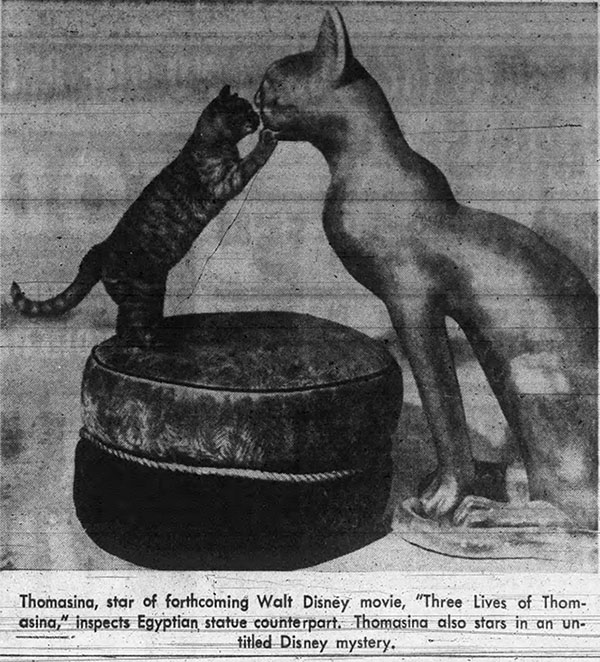
Paul Gallico’s Opinion – Yay or Nay?
So what did Paul Gallico think of Disney’s adaptation of his novel? The oft-repeated story (which is reportedly from Gallico’s memoirs) states that while the author was on the set of the film he came to dislike “the great god Disney” and was amused when one of the cat actors held up filming for two days by refusing to perform a specific stunt, in spite of Disney’s bellowing.
This seems to be in complete conflict with a story published in The Pittsburgh Press on September 26, 1969 which outlines Gallico’s set visit in a very different light:
Two Novels Sold
Walt Disney Way Pleases Paul Gallico
HOLLYWOOD — Paul Gallico, noted American author who recently sold “Scruffy” and “Abandoned,” two of his best-selling novels, to the Disney organization for film production, is pleased with the way that studio has adapted his work in the past.
His first association with the studio was in 1962 when the late Walt Disney purchased the film rights to Gallico’s “The Three Lives of Thomasina,” which made a successful motion picture that will be colorcast in two parts on “The Wonderful World of Disney,” over the NBC Television Network, Oct. 5 and 12.
During the filming, Disney invited Gallico to visit the location site.
“I almost refused because I’d been invited to watch filming a number of times on some of my other works but had to leave the set hurriedly because they were mutilating my story,” Gallico related afterward.
The former sports columnist added: “I went and I’m glad I did. It was the first time in my career that I was able to recognize my original work in what they were committing to film.” Gallico showed his interest by spending several days on the set watching the progress.
Bill Walsh, a Disney producer whose current film in release is “The Love Bug,” is developing “Scruffy” for feature production sometime next year. Gallico sent word from his home in France that he would like to pay a return visit to the studio when production begins.
It’s possible that Gallico was being more diplomatic at this point since he had just sold more material to Disney. Did the fact that neither story make it into production for the studio change Gallico’s mind about Disney?
Regardless of Gallico’s opinion of the finished product and the studio behind it, cat lovers cherish the film as a true testament of their love for their feline companions. In that way, Thomasina … and all cats … were and will always be gods.
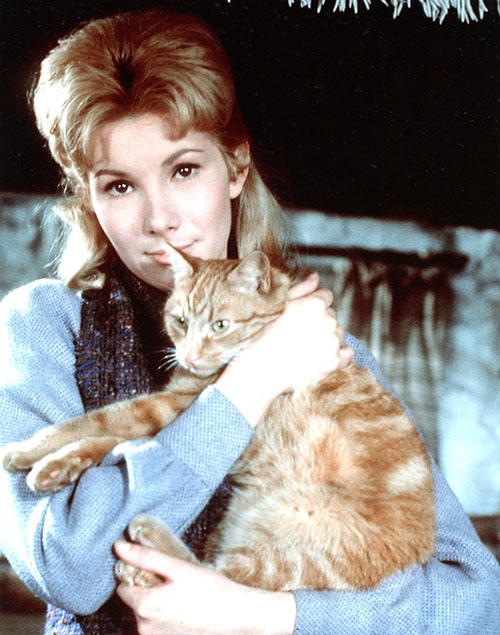
To discuss this story and other cats in movies and on television, join us on Facebook and Twitter.

